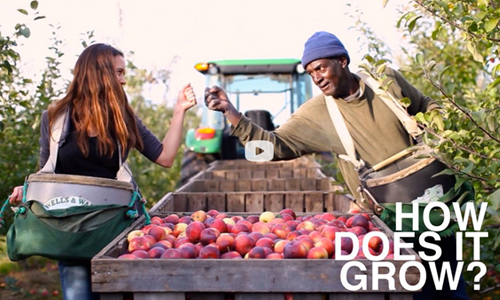

The U.S. is the second largest producer of apples in the world, and Americans eat more apples than any other fruit except bananas. Red Delicious and Grannysmith are ubiquitous in the U.S. And Honeycrisp, Pink Lady and Jonagold, among many others, are having their moment. So you might think that these sweet apple varieties are native to North America, but actually, before the Europeans arrived, one could only find sour crab apples on the continent.
In the latest episode of How Does It Grow?, a first-of-its-kind food education series that shares the stories of our food from field to fork, host Nicole Jolly offers up many interesting facts about the 7,500 varieties of apples that are grown in the world.
Jolly takes us to Middlefield, Connecticut, home to one of the oldest apple orchards in the country, to teach us about apples. The Lyman Family has owned this orchard since 1741. They bought the land directly from King George. Today, the ninth generation of Lyman’s operates this 100-acre orchard. That’s 27,500 trees growing 30 varieties of apples. The lifespan of an apple tree can be as short as 20 years and as long as 100.
Growing apples is not as easy as you might think. Because each apple seed is genetically unique, a Honeycrisp apple seed, for example, will not produce Honeycrisp apples. This is a problem for farmers trying to grow a specific variety of apple. So, growers use a technique called grafting, whereby they take a bud from the variety of apple they want to grow and insert it into the stock of a young apple tree to ensure that they get the variety they want.
Jolly also talks about the importance of pruning, cross-pollination, bees, culling and integrated pest management. The harvest begins in early August with the earliest varieties and finishes in late October. Harvesting is labor-intensive and every year a crew comes—some have been coming for 20 years—from Jamaica to harvest the Lyman’s apples. Some of the harvested apples go into low-oxygen storage, which “kind of puts the apples to sleep, so that they are available to eat the whole year round,” says Jolly. Apples are a nutritious and versatile food. But, Jolly cautions, almost all of the vitamins and fiber are in the peel, “so put down those peelers!”
The episode was made in partnership with Red Tomato, a nonprofit that works to deliver fresh, great tasting produce while cultivating a more sustainable, ethical food system.
YOU MIGHT ALSO LIKE
14 Superfood Salad Greens More Nutritious Than Kale

 233k
233k  41k
41k  Subscribe
Subscribe 